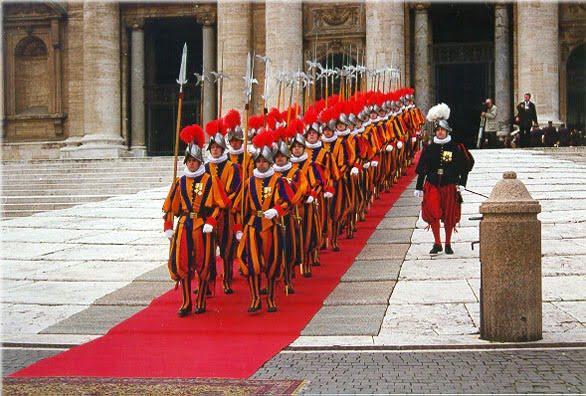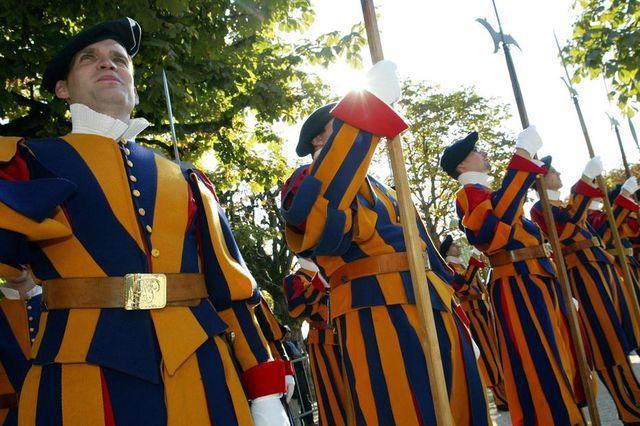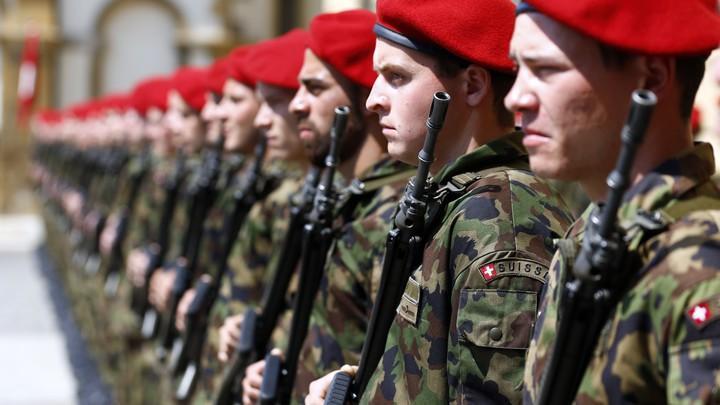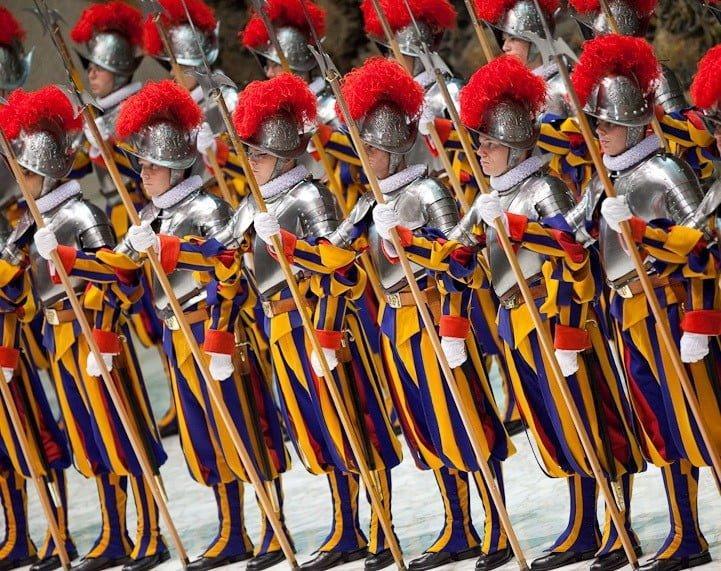Pontifical Swiss Guard is the historical unit in service as the Pontifical Swiss Guard of the Holy See. The unit is assembled from the Swiss soldiers who have served as bodyguards, ceremonial guards, and palace guards at foreign European courts since the late 15th century.
Introduction
Apart from the household and guard units mentioned above, regular Swiss mercenary regiments have served as line troops in various armies. They have been used in armies of France, Spain, and Naples up to the 19th century. In contemporary usage, the name Swiss Guard stands and generally refers to the Pontifical Swiss Guard of the Holy See.
Through a long history, Swiss Guards existed for hundreds of years in various units. The earliest such unit was the Swiss Hundred Guard (Cent Suisses) at the French court (1497 – 1830). Swiss Hundred Guard was a small force and was complemented in 1567 by a Swiss Guards regiment. The Papal Swiss Guard was founded in 1506 and is the only extant Swiss Guard. The Papal Swiss Guard is located in Vatican City. In the 18th and early 19th centuries, several other Swiss Guards existed in various European courts and countries.

Why are the Swiss soldiers protecting the Holy Father?
The use of Swiss soldiers as Royal guards and as the Pontifical Guard stems from the reputation of Swiss mercenaries at the time of their formation. Since Switzerland was a poor country, young men often sought their fortunes abroad. They had a reputation for discipline and loyalty. Among them, they have employed revolutionary battle tactics and they were considered the most powerful troops of the 15th century until the Landsknechte refined their methods in the early 16th century.
Mission
The Pontifical Swiss Guard is an exception to the Swiss rulings of 1874 and 1927. The Pontifical Swiss Guard is a relatively small force maintained by the Holy See. Their primary task is responsible for the safety of the Pope, including the security of the Apostolic Palace. The Pontifical Swiss Guard serves as the de facto military force of Vatican City.
The unit’s security mission is assisted by the Corps of Gendarmerie of Vatican City.

History
Their origins are from the 15th century, as Pope Sixtus IV (1471–1484) already made a previous alliance with the Swiss Confederation and built barracks in Via Pellegrino after foreseeing the possibility of recruiting Swiss mercenaries. After a period of inactivity, Innocent VIII (1484–1492) renewed the pact to use the Swiss mercenaries against the Duke of Milan. Alexander VI (1492–1503) later used the Swiss mercenaries during their alliance with the King of France.
During the Borgias, however, the Italian Wars began in which the Swiss mercenaries were a fixture in the front lines among the warring factions, sometimes for France and sometimes for the Holy See or the Holy Roman Empire, often leading the various forces and formations.
The mercenaries enlisted when they heard King Charles VIII of France was going to war with Naples. Among the participants in the war against Naples was Cardinal Giuliano Della Rovere, the future Pope Julius II (1503–1513), who was well acquainted with the Swiss, having been Bishop of Lausanne years earlier. The expedition failed in part thanks to new alliances made by Alexander VI against the French. When Cardinal Della Rovere became Pope Julius II in 1503, he asked the Swiss Diet to provide him with a constant corps of 200 Swiss mercenaries.
In September 1505, 150 soldiers started their march towards Rome under Kaspar von Silenen. They entered the city on January 22, 1506, today given as the official date of the Guard’s foundation. “The Swiss see the sad situation of the Church of God, Mother of Christianity, and realize how grave and dangerous it is that any tyrant, avid for wealth, can assault with impunity, the common Mother of Christianity,” declared Huldrych Zwingli, a Swiss Catholic who later became a Protestant reformer. Pope Julius II later granted them the title “Defenders of the Church’s freedom.”
During their service, the Swiss mercenaries’ forces varied greatly over the years and have even been disbanded. Its first and most significant, hostile engagement was on May 6, 1527, when 147 of the 189 Guards, including their commander, died fighting the troops of Holy Roman Emperor Charles V in the stand of the Swiss Guard during the Sack of Rome to allow Clement VII to escape through the Passetto di Borgo, escorted by the other 40 guards. The last stand battlefield is located on the left side of St Peter’s Basilica, close to the Campo Santo Teutonico (German Graveyard).
The Pontifical Swiss Guard has directly served the popes since the 16th century. Ceremonially, they shared duties in the Papal household with the Palatine Guard and Noble Guard, disbanding in 1970 under Paul VI. Today the Papal Swiss Guard has taken over the ceremonial roles of the former units. At the end of 2005, there were 135 members of the Pontifical Swiss Guard. This number consisted of a Commandant (bearing the rank of Oberst or Colonel), a chaplain, three officers, one sergeant-major (feldwebel), 30 NCOs, and 99 halberdiers, the rank equivalent to private (so-called because of their traditional Halberd).
Selection and training
All recruits to the guards must be Catholic, without exception, single males with Swiss citizenship who have completed basic training with the Swiss military and can obtain certificates of good conduct. Recruits must have a professional degree or high school diploma and must be between 19 and 30 years of age and at least 174 cm (5 ft 8.5 in) tall. In 2009, the Pontifical Swiss Guard commandant, Daniel Anrig, suggested that the Guard might someday be open to recruiting women. Still, he added that the admission of female recruits remained far in the future.

Qualified candidates must apply to serve. If accepted, new guards are sworn on May 6 every year in the San Damaso Courtyard (Italian: Cortile di San Damaso) in the Vatican (May 6 is the anniversary of the Sack of Rome). The chaplain of the Guard reads aloud the oath in the language of the Guard (mostly German).
The contract term (service) is between 2 and 25 years.
Weaponry and Gear
In their function as close protection officers, the Swiss Guard is equipped with the SIG Sauer P220 pistol and the SIG SG 550 rifle. Both weapons are in use by the Swiss Army. As recruits to the Swiss Guard must have passed basic military training in Switzerland, they are already familiar with these weapons when they begin their service. The pepper spray used by the Swiss Army (RSG-2000) is also in use. The plainclothes close protection officers are reportedly issued a Glock 19 pistol and Heckler & Koch MP7 submachine gun.
Traditional arms
- Sword
- Command baton
- Partisan
- Halberd
- Flamberge
- Cuirass with spaulders
Modern arms
- Dreyse M1907 (Retired from service)
- SIG P220 (P75)
- Glock 19
- Heckler & Koch MP5A3
- Heckler & Koch MP7-A1
- SIG SG 550
- SIG SG 552
Non-lethal weapons
- Pepper spray
- Tear gas
The Pontifical Swiss Guard history and the specifications of the service they provide rank them among the most respected profession in the world.





